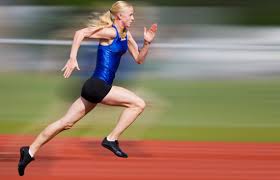I completely and wholeheartedly disagree.
Throughout this article, I will be referring to Heart Rate (HR) and appropriate percentages of your Maximum HR (Max HR) at which you should be racing. To ensure that you are racing at the proper HR, you first must know your Max HR. If you do not know this value, then you need to perform a test so you can determine this value. Using 220 - age is a common way to determine Maximal BPM. My Max HR is 191, but using 220-age my Max HR would be calculated at 173. Huge difference. There are other estimations that require you to know the square root of lightning as well. But here's the problem -- these formulas are estimations at best, and poor ones at that. A quick test can be done at the running track. This is a tough test. It will be uncomfortable and you have to go all-in if the goal is to register an accurate HR value from which to accurately calculate your training zones.
On a day when you're fairly rested, warm up as you would for a track workout. Then run 800m as hard as you can. If you don't have access to a track, then run for 3:00. You should run as hard as you can while maintaining a steady pace. Immediately jog easy for 100-200m or roughly 1:00. Then immediately run another 800m repeat as fast as you can. Really sprint the final 200m so you are running flat out to the end. When you cross the finish line, watch your HR monitor for a maximum HR registration. It will take several seconds to register, so keep an eye on your monitor. If you gave a 100%, honest effort, then you can take this value and add around 5 beats to figure an accurate Max HR from which you can work.
Next, you need to know how to accurately determine your HR zones. The first step is to take your Resting HR and subtract it from your Max HR. Ex: 195 (Max HR) – 35 (Resting HR) = 160. The next step is to calculate the HR zone in which you need to race (or train). Ex: 84-92%, which would be 134-147 (84% and 92% of 160, respectively). The final step is to add your Resting HR back into the equation to come up with your final HR zone values. Ex: 169-182 (Resting HR of 35 added to 134 & 147, respectively). So, in this example, the 84-92% zone for someone with a Max HR of 195 and resting HR of 35 would be 169-182. This is strictly for running. For cycling, you can subtract 4-10 beats from this value so that you are obtaining a HR at a similar level of effort (LOE). The reason is that due to the pounding of running, that you are standing straight up and using all your limbs to move, your HR will be higher running than it will be in either cycling or swimming.
I personally subtract 6 beats from my running values and use this for my cycling values. As for swimming, I use the same values as I do for cycling. The main thing to remember is that your LOE should FEEL similar from sport to sport. If it doesn't, then you need to adjust your HR zone up or down accordingly. So, if racing/training at 70-78% on the run feels a specific way, then you need to adjust your HR on the bike and in the swim so that these specific HR zones reflect a similar LOE as you put forth in running. If running at 70-78% feels comfortable and you can carry on a conversation with your running partner, then you shouldn't be out of breath and gasping for air when you hit the wall while swimming at 70- 78%.
For more comprehensive information on HR, blood lactate levels and overall physiological aspects of training and racing, “Training Lactate/Pulse rate” by Peter Jannsen is a valuable resource.
Take the time to quantify your specific HR zones and learn about how important they are to maximizing your success. Until you do, you won't be reaching your full potential. It is important to understand how HR zones and LOEs affect your performance at any given distance of race. By calculating HR zones, Masters athletes will have a much clearer picture of their proper training zones and how those relate to racing more effectively.
Happy Training,
Coach Nate


 RSS Feed
RSS Feed